List of Authors
>>About this blog
Recent blog post
|
[Hikoharu Co., Ltd.]
December 28, 2018 12:00
This time, we are planning to walk along the traces of a river that once existed in Chuo-ku. And this time the target is the Kyobashi River. The Kyobashi River, like the Sotobori River, is said to be a waterway that was excavated during the Keicho era. From the Sotobori River, the current border between Yaesu 2-chome and Ginza 1-chome was east, and at the end of Shiraoi Bridge, it joined Kaedegawa and Sakuragawa (Yachimachibori) Sanjumabori. Speaking of Shiraoibashi, it is also famous as one of Mitsuhashi.
Danshobashi ⇒ Kaedegawa Shiraoibashi ⇒ Kyobashigawa Shinpukuji Temple Bridge ⇒ Sanumabori
This time, we will walk from the site of Shiraoibashi to the vicinity of Sotobori-dori St.
In this Kyobashi River, there were bridges from the east (Sakuragawa): Shiraoi Bridge, Shinkyobashi, Sumitani Bridge, Kyobashi, Konya Bridge, and Jobe Bridge. And on the banks of the river were bamboo banks and radish banks. However, it was reclaimed from 1954 to 1959 and is now part of Tokyo Kosoku Doro. This highway is connected to the Metropolitan Expressway Urban Loop Line and the Yaesu Line. Tokyo Kosoku Doro is a private company engaged in real estate leasing business for buildings on the rooftop of free highways. I think there are some maps that are often described as KK lines.
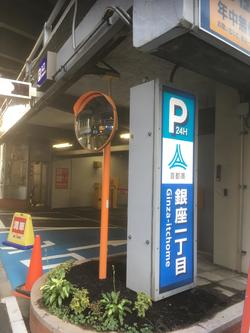 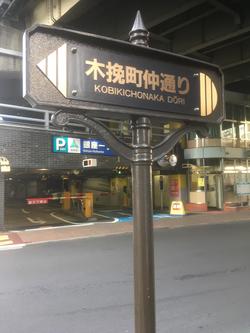
The photo above is a photo of the parking lot of Ginza 1-chome, but this jurisdiction was Metropolitan Expressway Co., Ltd. There were Shinkyobashi Exit and Higashiginza Exit of Tokyo Kosoku Doro ahead, so I think the real estate leasing business at high speed ahead is under the jurisdiction of Tokyo Kosoku Doro Co., Ltd.
And the street in front of you will be "Kibikicho Nakadori". It is said that Kibori-cho, which used to be on the east side of Ginza, was renamed Higashiginza to Nishi Ginza when Sanjumabori was reclaimed. In this way, it would be hot if the old town name was left in the street name. Then, follow the Kyobashi River ruins toward Sotobori-dori St. and cross Showa-dori. It is just near the site of Shinkyobashi.
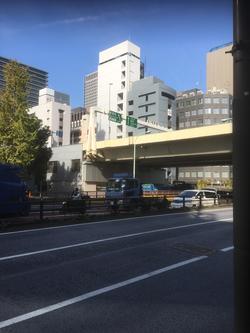 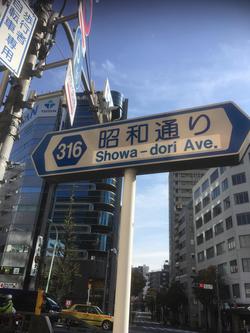
And I found a public bath "Ginza Yu" just a little from Showa-dori.
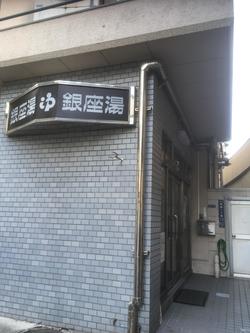
I was surprised that there was a public bath in Ginza 1-chome. But please be assured even in Ginza, the bathing fee is 460 yen for adults common in Tokyo. I couldn't take a bath this time, but men's bath's mural is the Sumida River Fireworks at the ladies' bath intersection of Ginza 4-chome. I want to take a bath at least once!
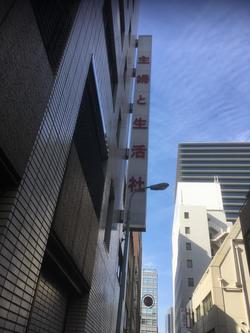 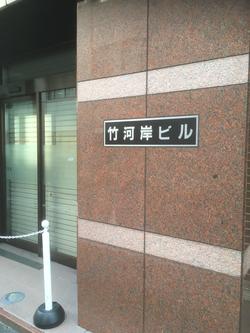
Then go on the left bank of the Kyobashi River ruins toward the Sotobori River ruins. I saw the signboard of the "Housewife and Lifesha" building and the bamboo riverbank building. Yes, this area prospered as the "bamboo riverbank" and it became around. During the Edo period, bamboo merchants gathered here, so it was called "Bamboo Riverside".
In addition, there is a famous police museum beyond that. Admission is free. Please come and visit us. A police car will meet you.
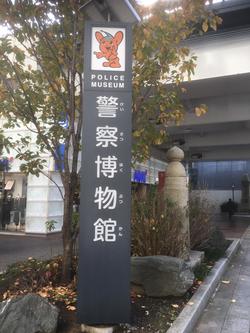 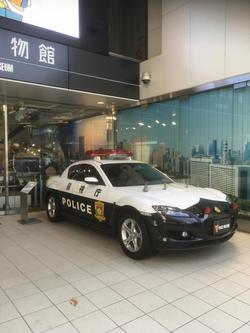
There is already Kyobashi in front of you. Kyobashi is said to be a bridge built in 1603, the same year as Nihonbashi. There are a number of historic sites around Kyobashi.
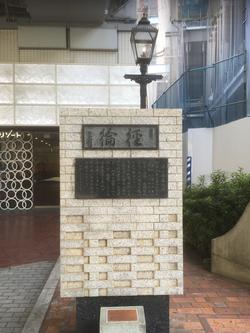 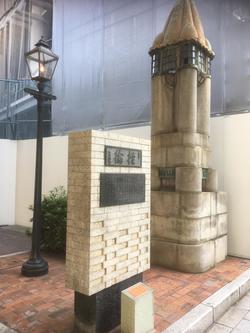
First of all, it is a monument of brick Ginza. With the great fire of Ginza in 1872, the Ginza Brick Street will be further promoted, and the brick street along Ginza Street will be completed in 1873. Behind the monument, a gas lamp illuminating the brick street has also been restored.
In addition, there are currently three main pillars in Kyobashi. The lower left photo shows two main pillars with giboshi on the stone arch bridge in 1875, and one main pillar of the 1922 Art Deco-style bridge next to the monument in Brick Ginza.
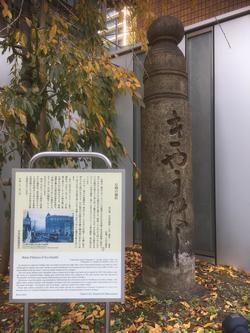 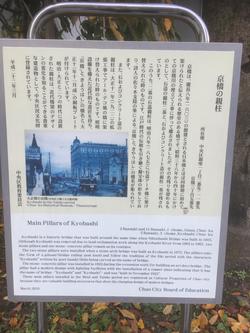
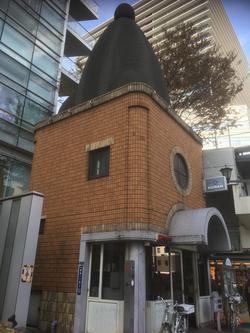 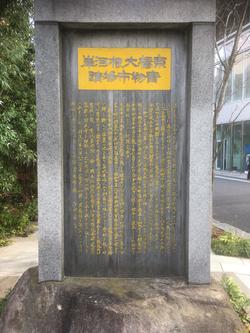
The police box next to Kyobashi imitates the main pillar of an Art Deco-style bridge in 1922.
The right side of the police box photo is a monument to the site of the Kyobashi Daikon Riverside Blue Market.
Since the Edo period, Kyobashi has been listed on vegetables mainly in radish, and there was a green market until before the Great Kanto Earthquake of 1923. It will be relocated to the former Tsukiji Market in 1935. And this year, it will be relocated to Toyosu Market in 2018.
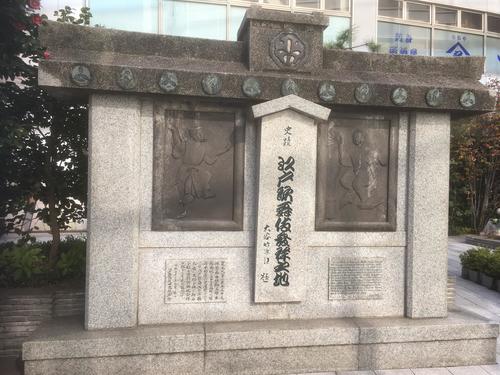
This monument is a monument to the birthplace of Edo Kabuki.
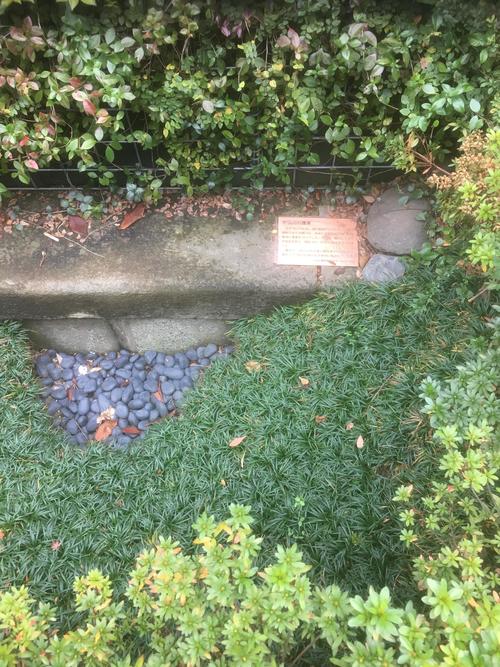
And there is a "Kyobashi River revetment" behind the monument at the site of the Kyobashi Daikon Riverside Blue Market. The copper plate in the photo was described as follows.
"Revetment of Kyobashi River"
"The Kyobashi River, which was excavated after Ieyasu Tokugawa entered Edo in 1590, had a riverbank on both banks and was an important river for logistics in the castle town. After that, it entered the modern age and finished its role, and was reclaimed from 1986 to 1940.
A part of the revetment has been reloaded since the modern era, and remains underground as it was at the time of landfill. " "Chuo-ku Environmental Civil Engineering Department Water and Green Division"
I was able to see the remain of the Kyobashi River this time.
In this way, the area near Kyobashi is a treasure trove of historic sites. If you look closely at the wording of the monument, it will pass an hour immediately.
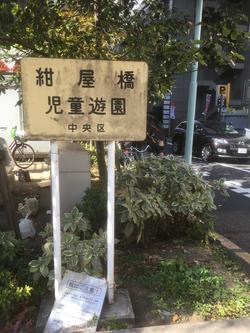 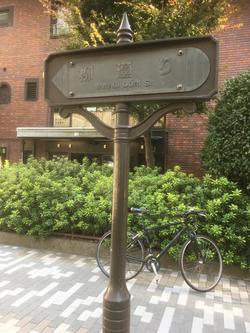
After passing Kyobashi and head toward Sotobori-dori St., you will cross Yanagi-dori St. This area is the ruins of Konya Bridge. In the upper part of the left bank, there was Konyabashi Children's Amusement Park, where the name "Konyabashi" remained. Of course, it was a park that used the site of Hashizume Square in Konyabashi.
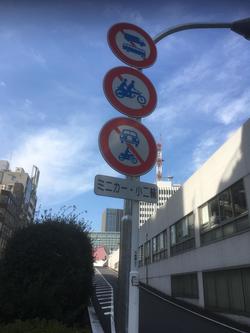 
The photo above is a photo of the entrance to Nishi Ginza in Tokyo Kosoku Doro, but I don't have a signboard with the green Nishi Ginza like the Metropolitan Expressway, so I'm the only one who feels hard to understand and difficult to enter? Everyone, please be careful when driving.

From now on, go along Ginza Sakura-dori St. on the right bank of the Kyobashi River to Sotobori-dori St. The site of the Kyobashi River was crowded with many commercial facilities and eating and drinking facilities.
And right in front of you, the traffic light of Yurakucho arrives at Sotobori-dori St.
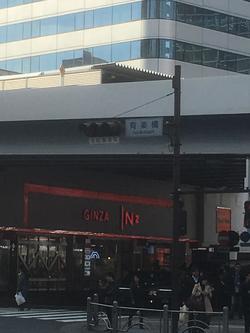 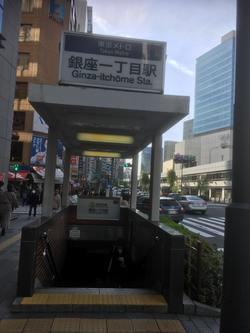
This walk has also arrived at the end of the city. The Kyobashi River was reclaimed for the construction of a motorway by Tokyo Kosoku Doro Co., Ltd. And under the highway there were parking lots, commercial facilities and beverage facilities. In the past, the only thing that made us realize that the river existed there was was the Kyobashi River revetment in Kyobashi. However, it was a town walk that guessed the existence of the Kyobashi River based on the names of the Takegawa River Bank Building and Konyabashi Children's Amusement Park.
[Hanes]
December 26, 2018 09:00
Hello. This is a new correspondent, Hanes. 
Christmas is over, and it is time to prepare for the New Year in earnest.
If you say what to do at this time, write New Year's cards, general cleaning, and sticking!
This time, I would like to introduce the mochi of Shintomi Town Association held on December 23 (Sun).
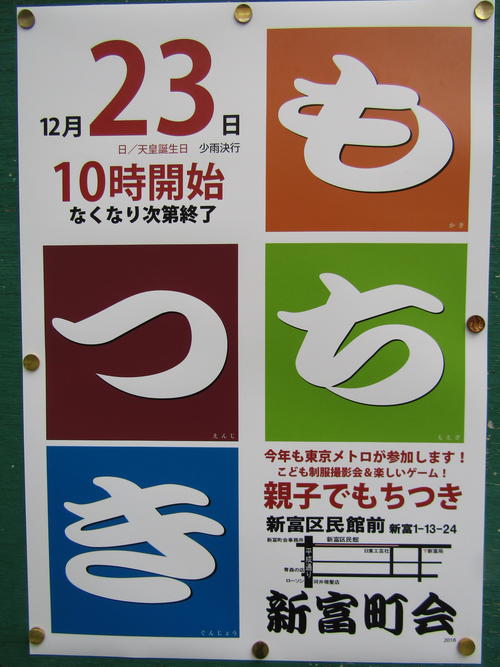
As shown in the flyer above, the venue was the street in front of Shintomi Kuminkan.
Many children gathered with the Tokyo Metro participating this year!
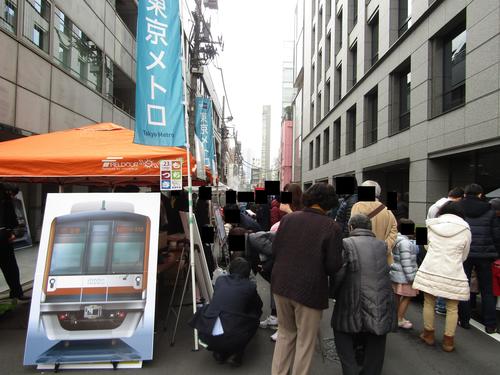
The opportunity to wear Tokyo Metro uniforms and take pictures with Metopon is valuable.
And looking at the panel of the train, the destination was "Shintomi Town Association Mochitsuki Tournament".
What a smart measure! I'm surprised to see this kind of device.
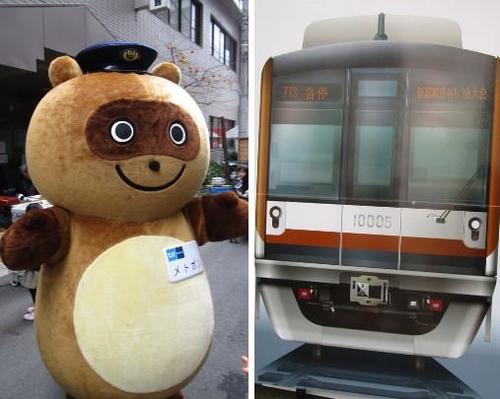
There was also a white bike ride experience and a VR earthquake experience corner.
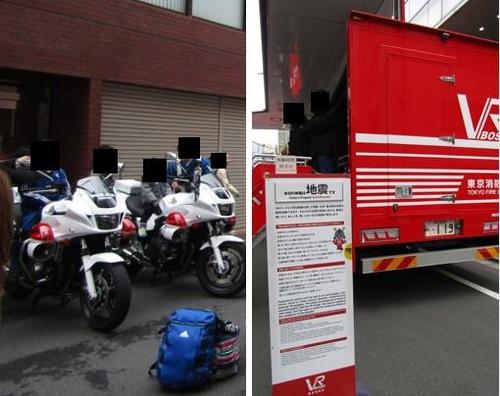
And when it comes to the main mochi, it's very authentic.
A convenient mochi machine has spread, and it has become difficult to see it!
Even in my hometown, I've only seen it at a traditional bun shop, but I'm sure you'll see it on the streets of Tokyo!
There is no doubt that the rice cake made with seiro is delicious.
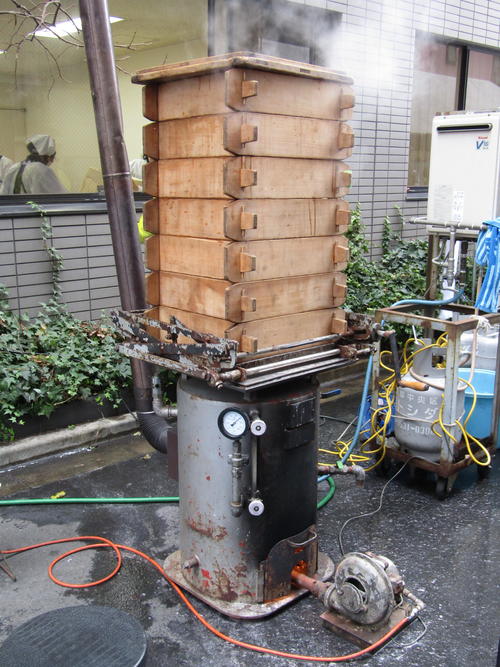
It's a rice cake that can be experienced regardless of men and women of all ages.
"Oh, it's good," said a vigorous shout.
There were also smiling scenes, such as veterans teaching young people tips on sticking.
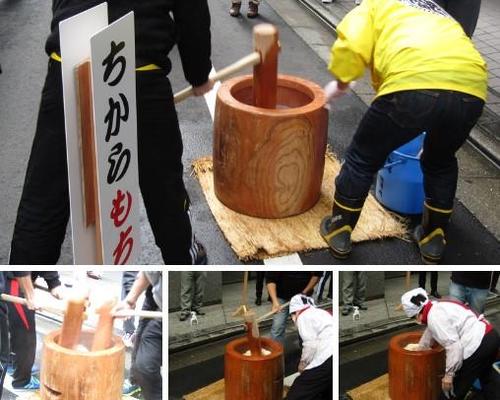
There was also a mayor of Chuo from Shintomi-cho, and I was able to see a little bit of the vision of Chuo-ku after the Tokyo 2020 Games.
The mochi was served as zoni, grated radish, kinakomochi, and anmochi, and was crowded with many people.
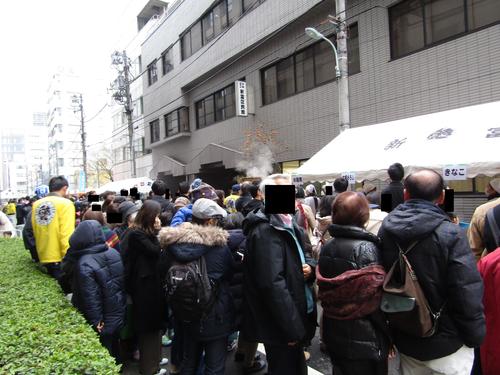
Thank you to the women who prepared the mochi skillfully!
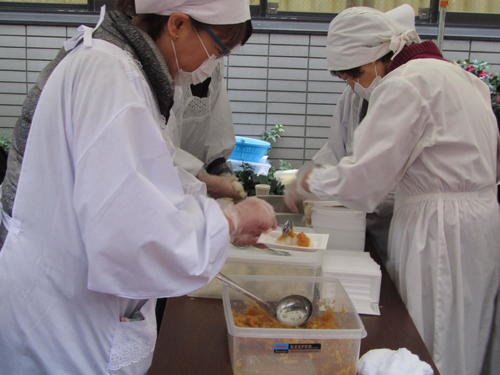
In the meantime, I had a zoni.
The soup stock was effective and the scent of yuzu was good.
Also, it's nice to have two large rice cakes.
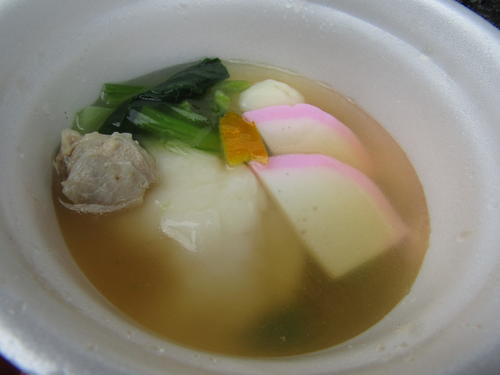
In addition, the sake "Shintomiza" was also served by adults.
Currently, the Kyobashi Tax Office is under construction, so you cannot see the information board at the site of Shintomiza.
Shintomiza (Relocated from Asakusa Saruwakacho in 1872. At that time, it was still called Morita-za) was used as a symbol of Civilization and enlightenment by using gas lamps.
It is said that the ninth generation Danjuro Ichikawa worked on a new historical drama (live history) and contributed to the development of the theater world.
It is an indispensable theater for talking about theater in Chuo-ku.
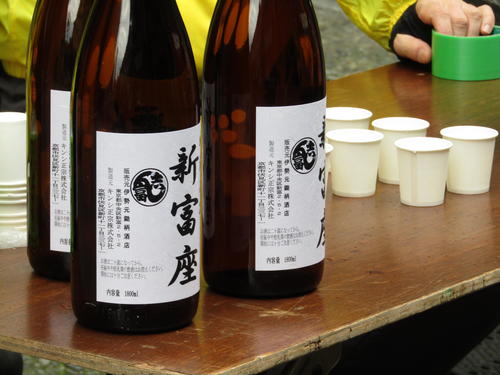
9 months since I started a correspondent...
One of the attractions of Chuo-ku that I discovered this year is the bonds of the community.
I came to Tokyo with the image that people in Tokyo have no neighborhood relationship and are cold.
It was an amazing and happy discovery
Next year, I would like to participate in local events and touch on the goodness of Chuo-ku.
※About this event, we have permission of introduction from town council.
[Hanes]
December 25, 2018 14:00
Hello. This is a new correspondent, Hanes. 
This is the final report of the 72nd National Tea Festival Report.
■Yoshimura Co., Ltd.
At this booth, we were able to compare matcha or sencha at different temperatures of HOT, COOL, and room temperature.
I choose matcha that I don't usually drink too much! Personally, I felt HOT was the most delicious.
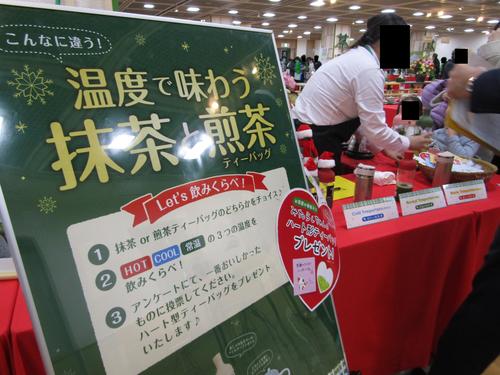
If you answer the questionnaire and vote for the temperature you feel the most delicious, you will be able to do so.
I received a heart-shaped tea bag tea (left photo).
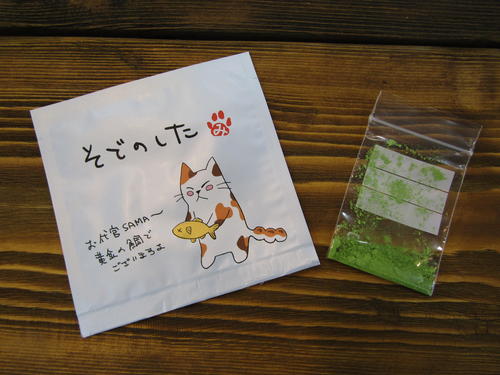
■Aichi Prefectural Horticulture and Agriculture Division (Nishio Tea Cooperative)
We had a milling experience here, and we were able to make matcha.
Turning the stone mill counterclockwise at a pace of roll once a second, maybe a little matcha came out of the gap!
Although it was a small amount, I was happy to have the matcha that I saw myself (right in the photo above).
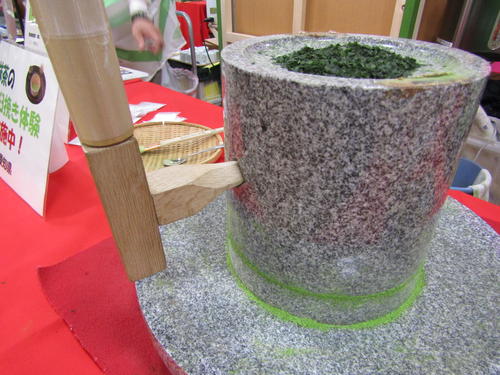
■Shizuoka Tea Commerce and Industry Cooperative
At this booth and adjacent table, where the letters "Shizuoka Tea BAR" are particularly eye-catching.
I chose one of the 17 kinds of tea from famous tea producing areas in Shizuoka Prefecture, and learned how to make delicious tea and taste it.
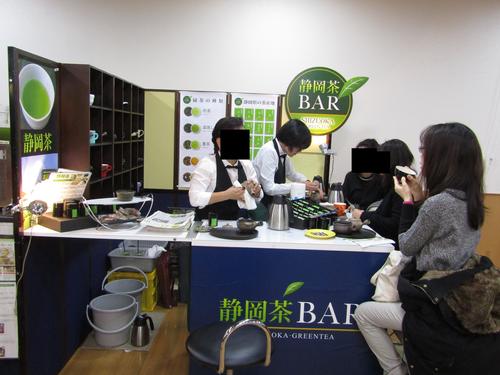
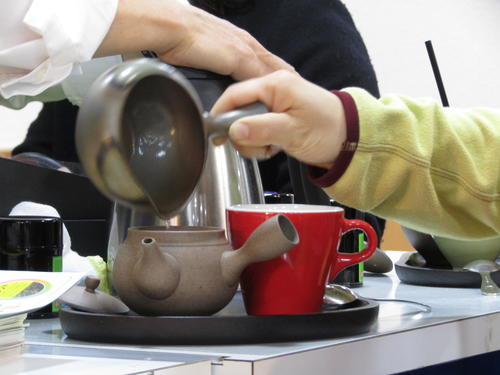
I chose Fukuroi tea, which depicts "Dechaya" in the Ukiyo-e of Hiroshige Utagawa at the post town in the middle of the Tokaido.
(Tokaido, Hiroshige Utagawa)...There is also a connection with Chuo-ku!
Fukuroi tea served by a traveler walking along the Tokaido....Don't you worry about it?
This tea is said to be "blue and clear green, and its freshness seems to be reminiscent of a specialty melon."...
Look at my tea in a slightly darker (3g) and I'm convinced.
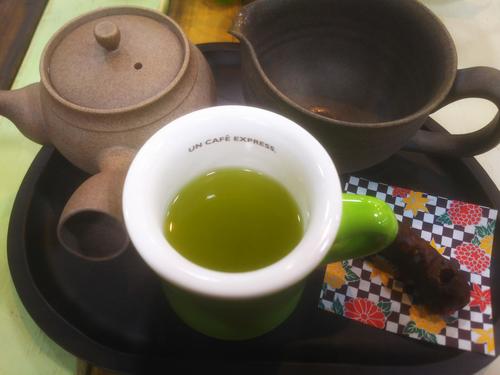
While talking about the tea teacher who was present and the parent and child who likes tea, each of them has chosen.
I had Karinto and Western sweets.
Two cups of tea can be brewed, and the first and second cups change the astringency.
I enjoyed both cups with fresh feeling.
After that, I answered the questionnaire and had this cold tea.
It's a stylish container, so if you shoot it with ikebana, it looks Instagrammable.
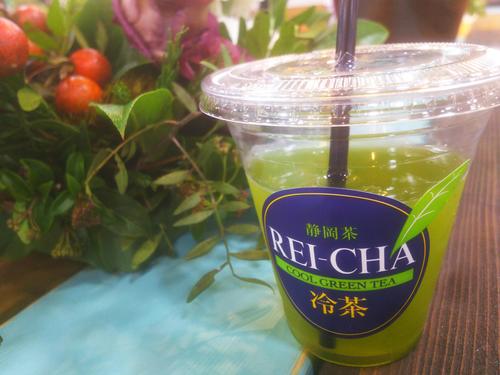
On the way home, I answered a questionnaire near the entrance of the venue and received two types of tea that I liked.
It was a very satisfying event that I couldn't think it was free, and it was a good opportunity to review the appeal of Japanese tea.
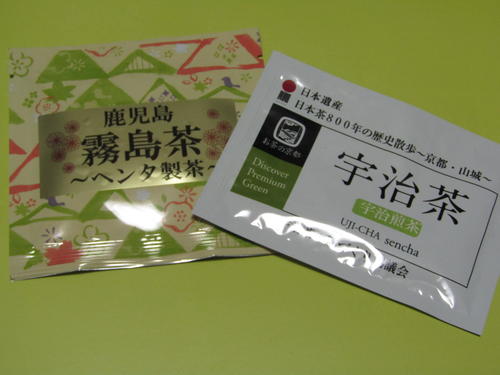
Even if you missed this opportunity, you can see the antenna shops in each prefecture in Chuo-ku.
You can buy a variety of teas from various places.
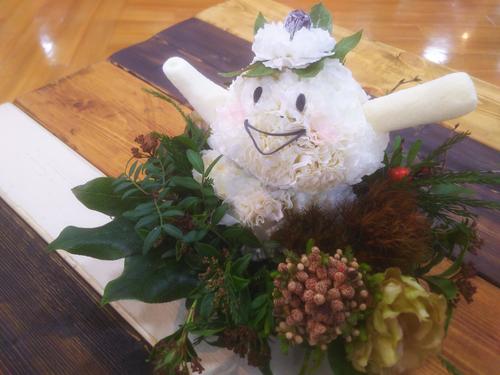
Why don't you drink warm Japanese tea this winter and rediscover the goodness?
※We have received permission to introduce this event from a representative of the Japan Tea Industry Central Association.
[Hanes]
December 24, 2018 18:00
Hello. This is a new correspondent, Hanes. 
The streets are getting more and more Christmas mood.
Everyone, are you preparing for Christmas smoothly?
The other day, when it comes to winter, it is associated with North Europe, so I introduced Scandinavian spots that can be enjoyed in the city.
A foreign country associated with Christmas is Christmas...I guess it's in Germany.
In particular, the Christmas market in Germany is famous!
And Queen Victoria of England married Prince Albert from Germany,
Following German customs, we decorated the Christmas tree at Windsor Castle.
A photo of the Queen's family celebrating Christmas around the tree was later published in the newspaper.
Christmas trees have become popular among English ordinary people.
That's why this time we will carefully select and deliver Germany that can be enjoyed in the city!
(In some places, the Chuo-ku Tourism Certification Measures are included .) .)
■German food
There are a number of German restaurants in the ward, and the one I would like to introduce this time.
It is Stein House Ginza, a German beer & wine specialty store in the Ginza Velvia Pavilion.
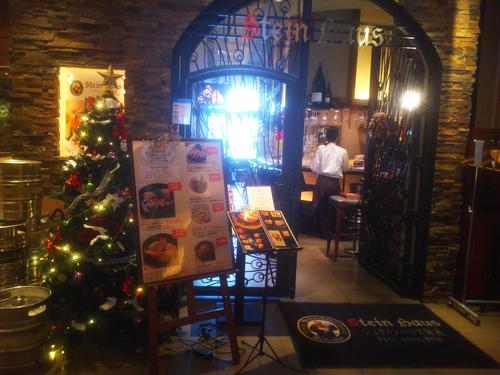
The reason why I chose this shop is that it has a good reputation for lunch!
For about 1,000 yen, you can enjoy German cuisine with a high level of authentic taste.
I ordered a hamburger lunch.
First of all, from the appetizers served well....
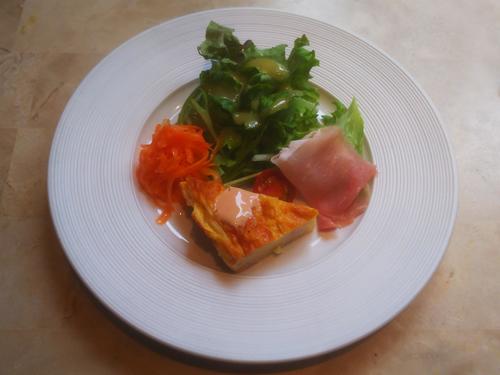
After a while, a good scent drifted softly from somewhere.
The main hamburger was brought in
Hamburg that has already been established in Japan, but its origin is Germany!
As you can see in English, it is derived from the food of Hamburg, Germany.
According to the Japan Hamburger Association, Japan
The origin of the hamburger is said to be "Tartal steak, which was popular among workers in Hamburg, a port town in Germany around the 18th century."

When you cut the 100% beef hamburger, it overflows with gravy.
The work laut was not too sour, and was just right.
In addition, there are also popular sausage lunch and daily lunch.
It's perfect for enjoying authentic beer and sausage at night!
After the meal, I photographed black tea with a stone wall reminiscent of an old European castle.
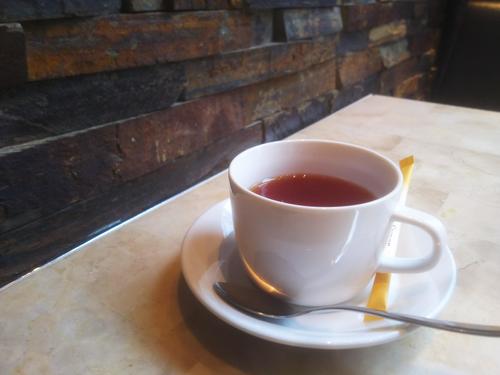
I've introduced the main dishes so far.
Actually, we are particular about this shop and interior, making it a fashionable space like Western Europe.
For that reason, it was popular with women, and some people used it at women's associations.
It is recommended when you want to have an affordable German lunch in Ginza!
[Stine House Ginza]
Address: 8F Ginza Velvia Hall 2-4-6 Ginza, Chuo-ku, Tokyo
Business hours Lunch month to Friday from 11:30 to 14:30
Saturdays, Sundays and public holidays 11:30-14:30
Dinner month to Friday from 17:00 to 23:00
Saturdays, Sundays and public holidays 17:00-23:00
※We have received permission from the person in charge of Stein House Ginza.
■Scenery like Germany
Did you know that there is Kiyosu Bridge, a bridge reminiscent of German scenery in Chuo-ku?
It is said that this bridge was modeled on a suspension bridge in Cologne.
Unfortunately, the bridge that became the model disappeared during World War II.
You can see some European-style gorgeousness on the Cheongju Bridge.
As Mr. Wienerhorn introduced the other day, Cheongju Bridge is currently under construction.
A little further away, I'm looking forward to seeing the beautiful bridge after the construction.
■Germans related to Chuo-ku
Those who take the sightseeing test may have already been in a pinch.
Yes, it's Siebold.
Since he came to Japan as a doctor of Dutch trading post, he has a deep relationship with the Netherlands, but actually German!

It is the birthplace of Edo Dutch studies, and since Siebold's daughter Ine opened a maternity hospital in Tsukiji.
A statue is set up in Akatsuki Park in honor of Siebold's achievements.
■German cultural facilities that I want to keep in mind
A reproduction picture scroll of "Kidai Shoran" is permanently installed on the underground concourse wall of Mitsukoshimae Station.
A bird's-eye view of the main street (currently Chuo-dori) from Nihonbashi to Imagawa Bridge around the 2nd year of culture (1805) from the east side, and before many buildings disappeared in the 1806 "Heitora Fire". It is a very valuable picture scroll (author unknown) that depicts the culture of townspeople in detail.
The picture scroll depicts 88 wholesalers and shops along the road, 1671 people coming and going, 20 dogs, 13 horses, 4 cows, 1 monkey, 2 hawks, etc. It is worth a look even though it is duplicated.
It's such a picture scroll, but the original picture is not in Tokyo, New York or London, but in the National Museum of Asian Art in Berlin.
There is a connection with Germany in unexpected places, so test takers need to check!
[Related Articles]
Nyanbo, "Nihonbashi of Kidai Shoran"
(What is a dog dropping that was a specialty of Edo? Click here for recommended references!
Mr. yaz "Kyodai Shoran Back Story"
(Lecture participation report. Click here for interesting stories that you can't know in Wikipedia!
Mr. Marsha Horiuchi of Edo "Life in Edo depicted in Kidai Shoran"
(Seminar Participation Report. If you want to go back in time during the Edo period, click here!
[Hanes]
December 23, 2018 09:00
Hello. This is a new correspondent, Hanes. 
This is the continuation of the 72nd National Tea Festival Report.
After a hand fir tea experience and tasting until 11:00 before, go to the long-awaited keynote speech.
Dr. Isao Kumakura, former president of Shizuoka University of Arts and Culture, under the theme of "Japanese Culture and Japanese Tea".
The more you know, the more interesting the history of tea, the easier it is to understand.
Here's a brief introduction to some of them.

■History of Tea in Japan
・It was introduced from China during the time of Emperor Saga.
・In 815, "Nippon Shoki" states, "Emperor Saga was served by Emperor Saga by roasting tea at Bonshakuji Temple in Oomi." This is the first description of Japanese tea in the country's history book.
・Tea cultivation has already been carried out in the early Heian period, and you can see the word "tea garden" in the upper right of the "Heian-kyo Ouchi Back Figure". Because it is located in the upper right, in other words, unlucky direction in the Tohoku region, it seems that tea had the meaning of breaking down evil. There is also a description that tea was planted in the grave.
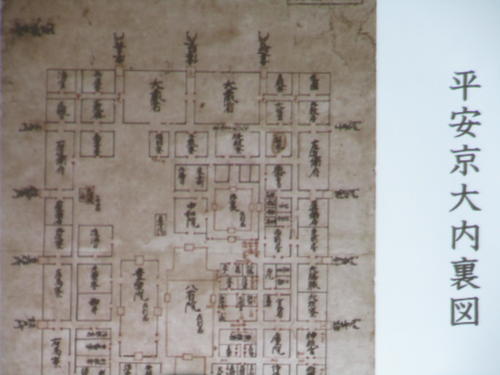
・In Meian Eisai's "Cafe Yoseiki", "Tea is a herbal medicine for curing. It's a magic of age."
・Tea was brought not for the health of the Japanese, but for the ceremony of Zen sect. Zen sect was influenced by samurai, and tea spread to common people through samurai.
・At the beginning of the 15th century, tea sales began to sell green tea in Kyoto.
・In "Takao Kankae Figure Screen", sake (man, spicy) and tea (female, sweet) are compared and drawn.
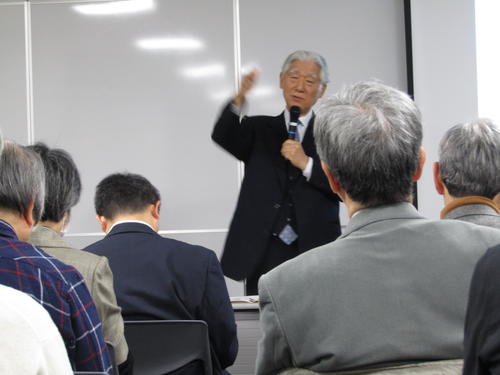
・The tea room in the mountain (the entrance is narrow) was also considered as an entrance to another world from the view of Yamanaka and other worlds, or as an entrance reborn from the same way of thinking as a passing through the womb.
・The song "I wake up Taihei's sleep, I can't sleep at night because I can't sleep at night" has a meaning behind the scenes. It is said that as a result of drinking 4 cups of Uji's fine tea "Kamikisen", he could not sleep at night due to caffeine.
・ More than 20 kinds of teas collected by Siebold are located at the Leiden National Museum of Ethnology in the Netherlands, in which "Kamikisen" is located.

・From the end of the Tokugawa period, tea exports became popular. Whether or not there are crops that can be exported overseas determines whether modernization (acquire foreign currency and obtain overseas information and technology). In Japan, there were silk and tea (at peak, 25,000 tons (25% of total exports)).
・In recent years, domestic demand for tea and soy sauce (one-half consumption of the Edo period) has been sluggish, while overseas demand has increased.
I tried to make a bullet point so easily, but the arrival of Kurofune → Kamikisen → There was also a connection with Siebold, an unexpected Chuo-ku.
Before the excitement of such unexpected discoveries cooled down, go to the rest of the booth!
■Mino Ibi Tea Promotion Association
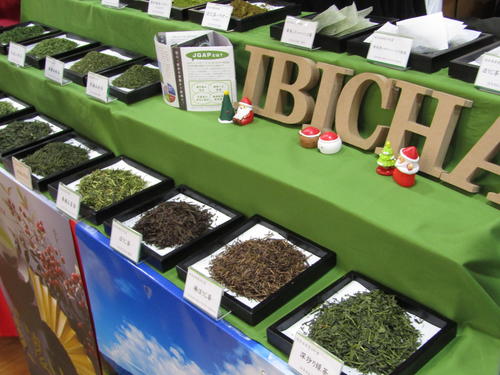
■JA Shizuoka Keizai Federation
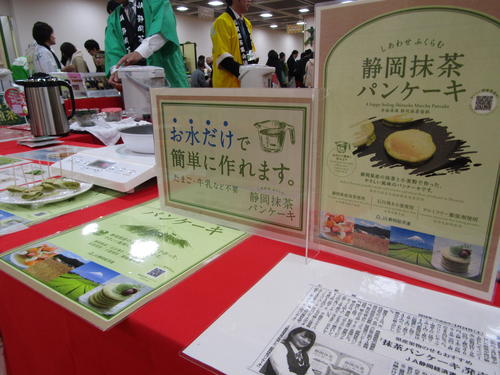
■Tamaya Co., Ltd.
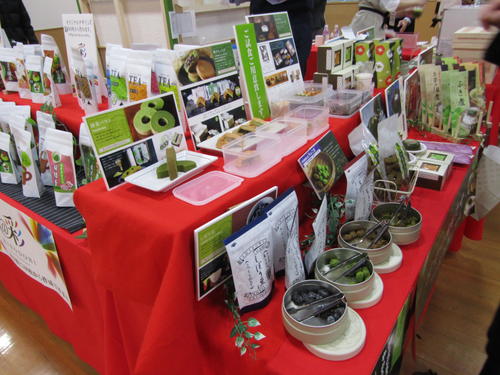
■Choju Suzuki Shoten Co., Ltd.
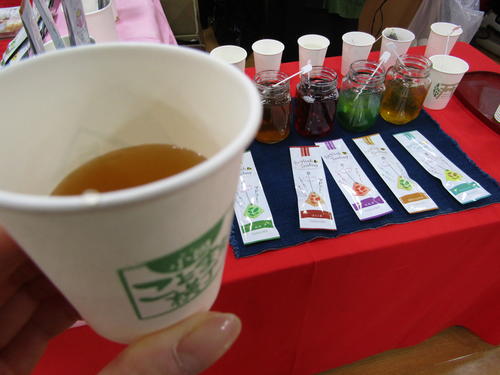
■Fukuoka Tea Industry Promotion Council
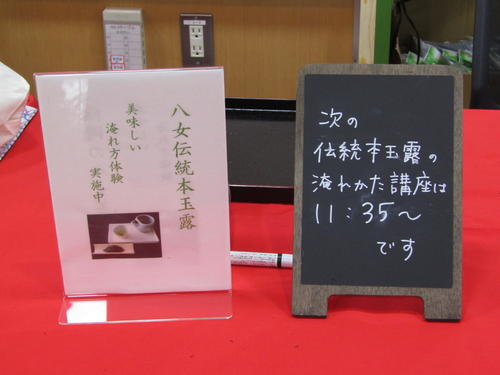
■The Nogi Tea Promotion Council, the Tosa Tea Sales Countermeasures Council in the All-Agricultural Kochi Agricultural Products Sales Section
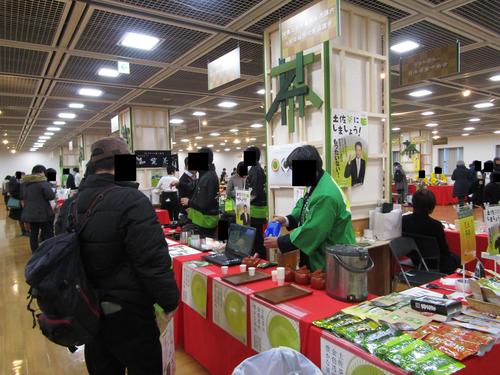
This is part of the exhibition booth, but from tea leaves to handy types of tea with tea bags and madlers are available.
From the introduction of sweets using tea to the brewing course, can you tell us that it is really fulfilling?
But this is not the end of the tea festival!
The booth (part) where you can experience the charm of tea with your five senses will be introduced in the next article.
■Recommendation Books
Sakae Tsunoyama, "The World History of Tea Revised Green Tea Culture and Tea Society" (Nakakou Shinsho, 2017).
Satoru Matsushita's "Japanese Tea" (Fengyusha, 1969).
■Reference website
Isao Kumakura, "Tea and Japanese", Journal of Medical History, Vol. 45, No. 2 (1999), pp. 155-157.
http://jsmh.umin.jp/journal/45-2/155-157.pdf
[Asunaro]
December 22, 2018 18:00
Nakahashi of the former Momiji River.
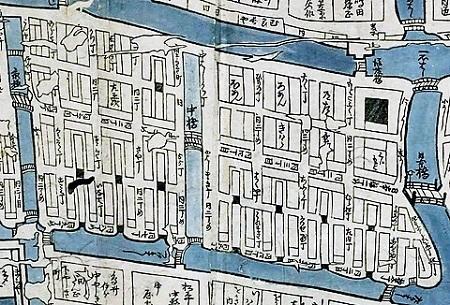
From the central exit of Tokyo Station Yaesu to Kuyasubashi on Yaesu Street
It's the ruins of the Momiji River. It was in the direction of Momijiyama in Edo Castle Nishinomaru.
For this reason, it was named Momiji River.
Momiji River and Dorimachisuji (Chuo-dori)
The crossing bridge was Nakahashi.
In 1624, Minamizume of Nakahashi was the founder of Edo Kabuki.
Saruwaka (Nakamura) Kanzaburo opened a playhouse for the first time in Edo.
It's the place where I hung it.
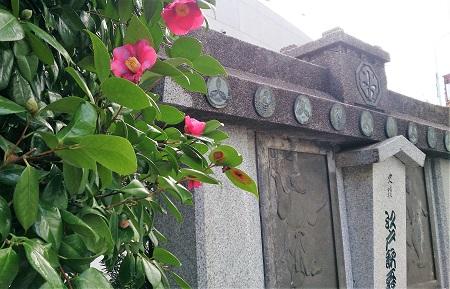
The stone monument of the birthplace of Edo Kabuki is located in the southern part of Nakahashi.
It is located on the shore of the radish on the site of Kyobashi, 500m away.
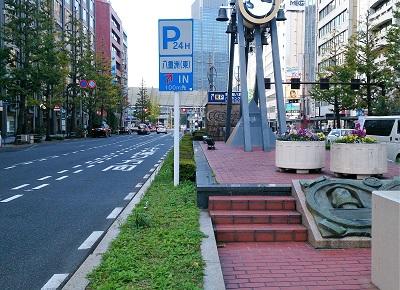
From the Nihonbashi 3-chome intersection where Nakahashi was built
Looking west, the front is the Yaesu Central Exit of Tokyo Station.
There is a green belt in the foreground strip.
I have a relief from Jan Jooss Ten.
Developed as a place for commercial activities in Edo, the life culture of townspeople
The giboshi has supported the cultural information as well as the formalities.
It has become a lively place in the field of communication.
It is located in the 10th section of Hakone Ekiden, a feature of New Year's Day.
Why don't you check it with roadside support?
◆Edosho, Toyoshima-gun, Bushu
National Diet Library Digital Collection
◆The birthplace of Edo Kabuki
3-4, Kyobashi, Chuo-ku, Tokyo
◆Relief from Jan Jooss Ten
3, Nihonbashi, Chuo-ku, Tokyo Intersection
|
Links
|






























































